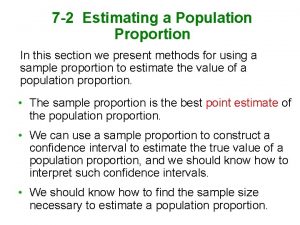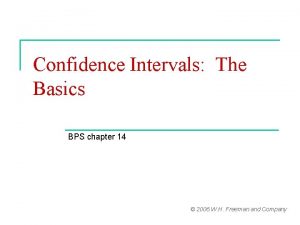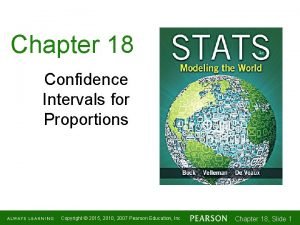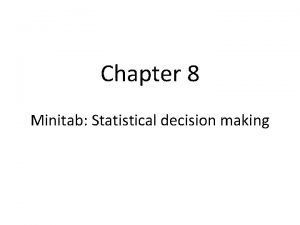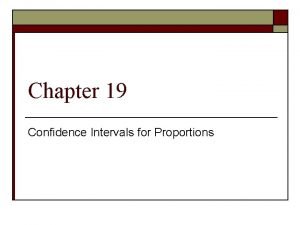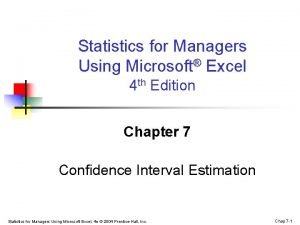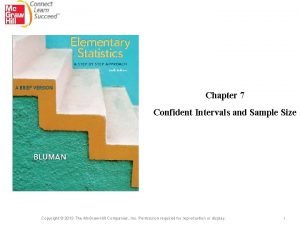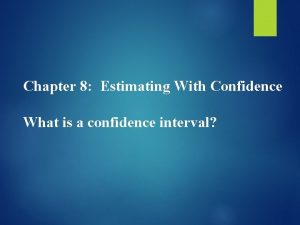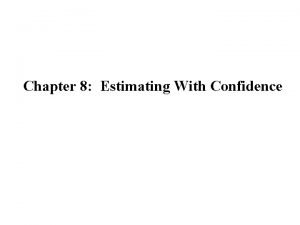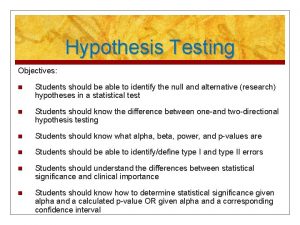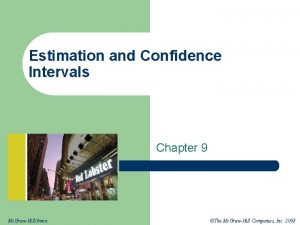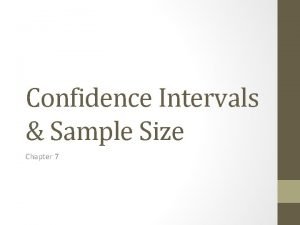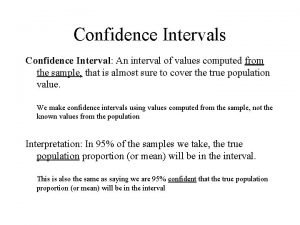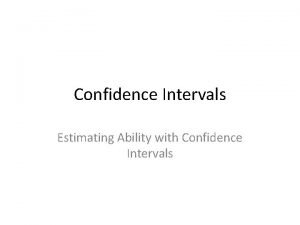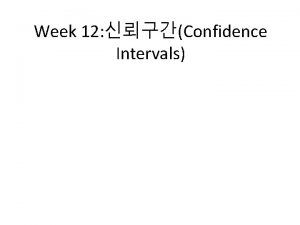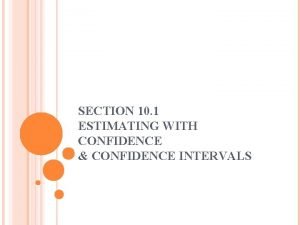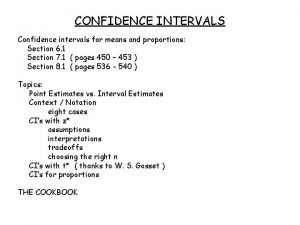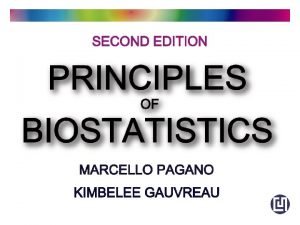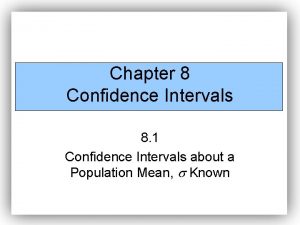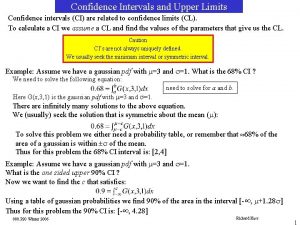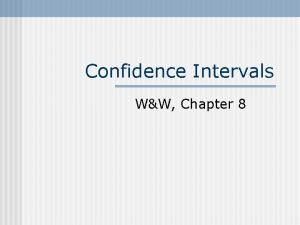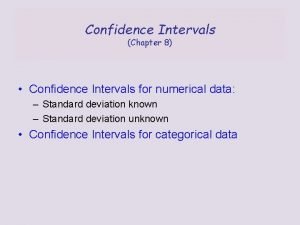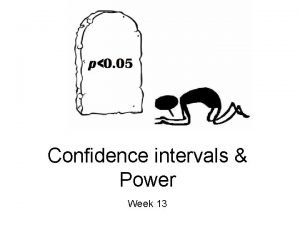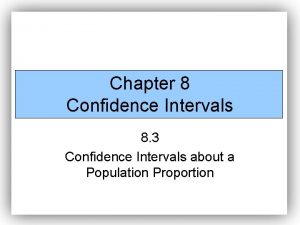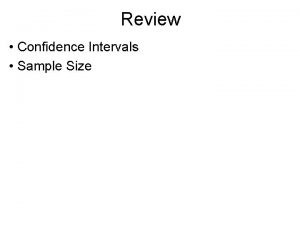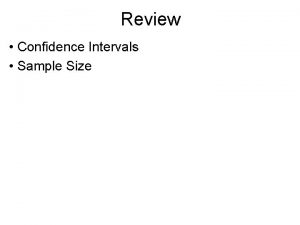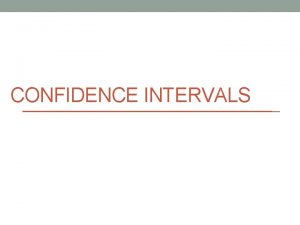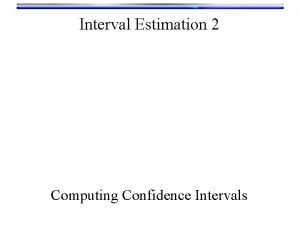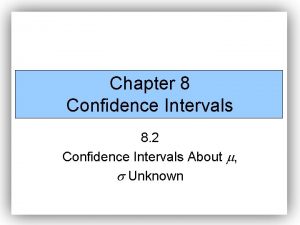Confidence Intervals Estimating Population Proportion Section 8 2























- Slides: 23

Confidence Intervals: Estimating Population Proportion Section 8. 2 Reference Text: The Practice of Statistics, Fourth Edition. Starnes, Yates, Moore

Objectives •

So… • In 8. 1, we saw that a confidence interval can be used to estimate an unknown population parameter. We are often interested in estimating the proportion p of some outcome in the population. Some examples: • What proportion of US adults are unemployed right now? • What proportion of high school students cheated on a test? • What proportion of a company’s lap top batteries last as long as the company claims? • This section shows us how to construct and interpret a confidence interval for a population proportion.


Normal Conditions and Standard Deviation •

• Conditions for Constructing A Confidence Interval

Check Your Understanding • In each of the following settings, check whether the conditions for calculating a confidence interval for the population proportion p are met. • Conditions: Random, Normal, Independent • 1. An AP Statistics class at a large high school conducts a survey. They ask the first 100 students to arrive at school one morning whether or not they slept at least 8 hours the night before. Only 17 students say “Yes. ” • 2. A quality control inspector takes a random sample of 25 bags of potato chips from the thousands of bags filled in an hour. Of the bags selected, 3 had too much salt.

Calculating a Confidence interval for p. •

• Finding the critical value for a 95% confidence interval, we look at the area under the curve that’s NOT being accounted for. 100%-95% =5% / 2 tails = 2. 5% each tail

Example: • PROBLEM: Use Table A to find the critical value z* for an 80% confidence interval. Assume that the Normal condition is met.

Example Cont… • SOLUTION: For an 80% confidence level, we need to catch the central 80% of the standard Normal distribution. In catching the central 80%, we leave out 20%, or 10% in each tail. So the desired critical value z* is the point with area 0. 1 to its right under the standard Normal curve. The table shows the details in picture form: • Search the body of Table a to find the point −z* with area 0. 1 to its left. The closest entry is z = − 1. 28. (See the excerpt from Table A above. ) So the critical value we want is z* = 1. 28.

Calculator to find my Critical Value! We are AP, and AP is pressed for time! How to find the critical value on your calc: 2 nd>Vars (distr) >3: inv. Norm( >Enter > fill in the following inv. Norm(. 05, 0, 1). 05 = area to the left of the curve, 0 and 1 are just to state it’s a standard Normal curve. The Calculator makes Table A obsolete!

One Sample Z Interval for a Population Proportion •

Example of a 1 -prop Z interval • PROBLEM: Mr. Vignolini’s class took an SRS of beads from the container and got 107 red beads and 144 white beads, making a total of 251 beads. We are using p = red beads. • (a) Calculate and interpret a 90% confidence interval for p. • (b) Mr. Vignolini claims that exactly half of the beads in the container are red. Use your result from (a) to comment on this claim.

Example Cont… •

Calculator! • We are AP, and AP is pressed for time! How to construct an confidence interval for population proportion: TI 83/84 STAT> TESTS> A: 1 -Prop. ZInt> enter information in X, n, and C-level> highlight Calculate> Enter TI 89 Statistics/List editor>2 nd>F 2 (F 7) > 5: 1 prop. Zint

Calculator Practice: • We’ll demonstrate using the example of n = 439 teens surveyed, X = 246 said they thought that young people should go to college. Use your calculator to calc the interval: TI 83/84 STAT> TESTS> A: 1 -Prop. ZInt> enter information in X, n, and C-level> highlight Calculate> Enter TI 89 Statistics/List editor>2 nd>F 2 (F 7) > 5: 1 -prop. Zint

AP Warning! • AP EXAM TIP You may use your calculator to compute a confidence interval on the AP exam. But there’s a risk involved. If you just give the calculator answer with no work, you’ll get either full credit for the “Do” step (if the interval is correct) or no credit (if it’s wrong). We recommend showing the calculation with the appropriate formula and then checking with your calculator. If you opt for the calculator-only method, be sure to name the procedure (e. g. , one-proportion z interval) and to give the interval (e. g. , 0. 514 to 0. 606).

Putting it all Together: A Four-Step Process • State: what parameter do you want to estimate, and at what confidence level? • Plan: Identify the appropriate inference method. Check conditions. • Do: If the conditions are met, preform calculations. • Conclude: Interpret your interval in the context of the problem. • AP expects ALL FOUR, do not skip step 1!

Example: See Handout for article: Teens Say Sex Can Wait

Choosing the Sample Size •

Objectives •

Homework Worksheet
 Estimating a population proportion
Estimating a population proportion Importance of confidence interval
Importance of confidence interval 96 confidence interval z score
96 confidence interval z score Reporting confidence intervals
Reporting confidence intervals 95 confidence interval t score
95 confidence interval t score Chapter 19 confidence intervals for proportions
Chapter 19 confidence intervals for proportions Confidence interval for proportion excel
Confidence interval for proportion excel Chapter 18 confidence intervals for proportions
Chapter 18 confidence intervals for proportions Ti 84 confidence interval
Ti 84 confidence interval Confidence interval minitab
Confidence interval minitab Chapter 19 confidence intervals for proportions
Chapter 19 confidence intervals for proportions How to add 95 confidence intervals in excel
How to add 95 confidence intervals in excel Confident
Confident Chapter 8 estimating with confidence
Chapter 8 estimating with confidence Suppose your class is investigating the weights of snickers
Suppose your class is investigating the weights of snickers Chapter 8 estimating with confidence
Chapter 8 estimating with confidence Section 1 population dynamics answer key
Section 1 population dynamics answer key Population ecology section 1 population dynamics
Population ecology section 1 population dynamics Population ecology section 1 population dynamics
Population ecology section 1 population dynamics Chapter 4 section 1 population dynamics answer key
Chapter 4 section 1 population dynamics answer key Confidence interval vs confidence level
Confidence interval vs confidence level Confidence interval formula proportion
Confidence interval formula proportion Confidence interval for sample proportion
Confidence interval for sample proportion Confidence interval for sample proportion
Confidence interval for sample proportion
